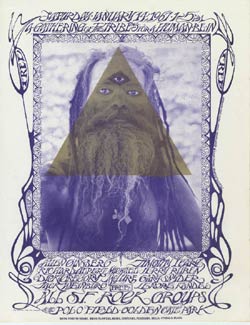Human Be-In facts for kids
| Part of the Hippie movement | |

Poster advertising the 'Human Be-In', designed by Stanley Mouse (artist) and Michael Bowen (concept), using the photograph of artist Casey Sonnabend
|
|
| Date | January 14, 1967 |
|---|---|
| Location | San Francisco, United States |
| Participants | Possibly 20,000–30,000 people |
| Outcome | Inspiration for the Summer of Love |
The Human Be-In was a big gathering held in San Francisco's Golden Gate Park on January 14, 1967. It was like a warm-up for San Francisco's famous Summer of Love. This event helped make the Haight-Ashbury area a well-known symbol of the American counterculture. It also introduced new ideas and ways of thinking to many people.
Contents
What Was the Counterculture?
The Human Be-In brought together many important ideas of the 1960s counterculture. These ideas included believing in yourself, wanting less control from big governments, living together in communities, caring for nature, and exploring new ways of thinking. The hippie movement grew from students and artists in San Francisco. They wanted to be spontaneous and rejected some traditional ideas. Poet Allen Ginsberg helped connect the earlier "Beat Generation" with the hippies.
How Protests Inspired the Name
The name "Human Be-In" came from artist Michael Bowen. It playfully combined ideas of human kindness with the many "sit-in" protests happening at the time. These sit-ins were peaceful ways to change rules at colleges and end segregation. For example, students would sit at lunch counters where Black people were not allowed. The first big "teach-in" was organized by Students for a Democratic Society in 1965.
The Big Event in Golden Gate Park
The Human Be-In was announced as "A Gathering of the Tribes for a Human Be-In." Michael Bowen invited all the speakers. Timothy Leary spoke, encouraging people to "turn on, tune in, drop out," which meant to explore new ideas, be aware, and step away from old ways of thinking. Other speakers included Richard Alpert (later known as "Ram Dass"), and poets like Allen Ginsberg and Gary Snyder.
Many local rock bands played music. These included Jefferson Airplane, The Grateful Dead, Big Brother and the Holding Company, Quicksilver Messenger Service, and Blue Cheer. These bands were already popular in San Francisco's music scene.
The event surprised the national news. Reports said between 20,000 and 30,000 people came to the Be-In. After this, many other gatherings were called "-In" events. For example, there was a "Human Fly-In," a "Sweep-In," and even a TV comedy show called Laugh-In. Later, John Lennon and Yoko Ono had their famous "Bed-In" for peace.
The Human Be-In brought together different groups in San Francisco's counterculture. On one side were the Berkeley radicals, who were becoming more active against the Vietnam War. On the other side were the Haight-Ashbury hippies, who preferred peaceful protests. Even though their methods were different, they shared many of the same goals.
What Came After: The Legacy
The counterculture that grew from the "Human Be-In" encouraged people to question authority. This led to important changes in civil rights, women's rights, and consumer rights. New ways for people to get information, like underground newspapers and radio stations, also started.
Another Human Be-In was held in Denver, Colorado in July 1967. It attracted 5,000 people and featured bands like the Grateful Dead. Later, the idea of "Be-Ins" even inspired "Digital Be-Ins" in the digital world. A UK theatre company, Theatre 14167, took its name from the date of the original Be-In.
See also
 In Spanish: Human Be-In para niños
In Spanish: Human Be-In para niños

